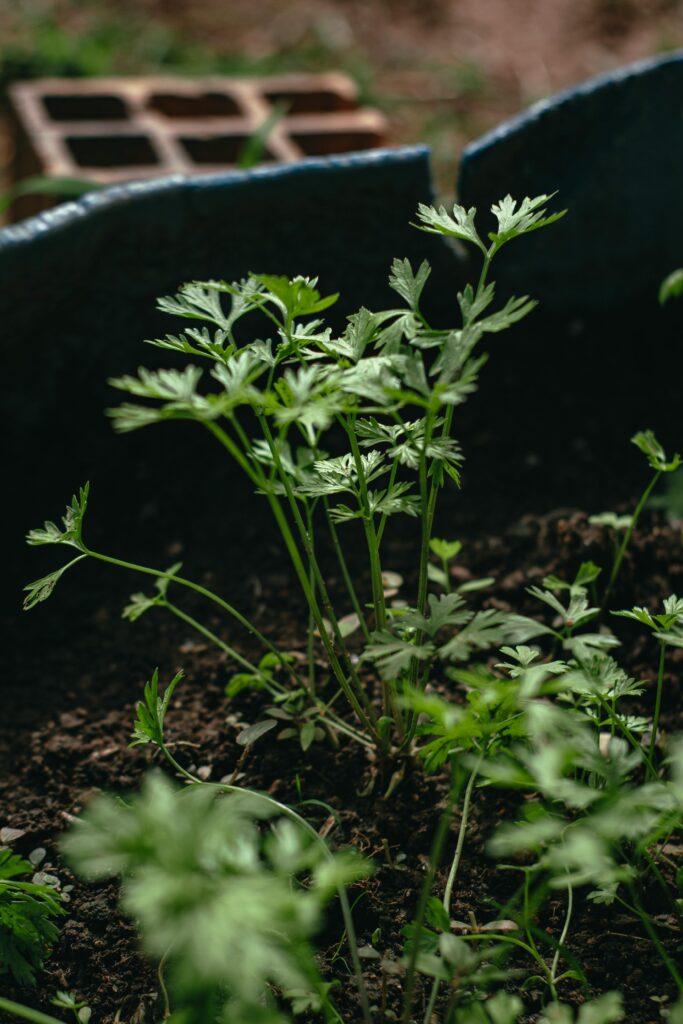
If you think parsley is only good as a garnish on the salad bar, you’re missing out on the incredible flavor and benefits this humble herb has to offer. Native to the Mediterranean, parsley has been a staple in the region’s cuisine for thousands of years. The ancient Greeks even used it to decorate the graves of loved ones—it was that revered!
But you don’t have to wait until you’re dead and buried to enjoy parsley. This fragrant, nutrient-rich herb is incredibly easy to grow, and once it’s established, it will fill your food with flavor all season long.
Ready to get started? Here’s everything you need to know to start growing parsley in your own garden.
Start Growing Parlsey
When and Where Should You Grow Parsley?
Parsley can grow just about anywhere—as long as it gets 6–8 hours of sunlight per day and consistent watering. In hot climates, give it a bit of afternoon shade to prevent premature bolting. It’s also a great herb for container gardening, which makes it easy to move around as needed.
How to Plant Parsley
Although it belongs to the same family as carrots, parsley is a bit more forgiving about root disturbance and can be started indoors and transplanted outside once the danger of frost has passed. Whether you direct sow or transplant depends on your climate and the length of your summer growing season.
Tips for Germinating Parsley Seeds
Parsley has a reputation for slow germination—it can take up to a month to sprout if conditions aren’t ideal. Speed up the process by soaking seeds overnight before planting.
Starting Parsley Indoors
If you’re in a colder region, start seeds indoors 6–8 weeks before your last frost.
- Use seed trays or repurpose egg cartons.
- Plant several seeds per cell to account for low germination.
- Seeds need light to germinate, so don’t bury them—just press them lightly into the surface of the soil.
- Use a plastic cover to retain moisture and warmth.
Preparing Your Garden Bed
Parsley isn’t too picky but thrives in well-prepared soil.
- Add compost and till it in about 6 inches deep.
- Aim for a pH between 6.0–7.0.
- Parsley loves nitrogen, so incorporate a nitrogen-rich amendment like composted manure.
Transplanting Outdoors
Once seedlings have at least two true leaves and nighttime temps are above freezing, harden them off by placing them outside for a few hours each day for a week.
- Plant 4–8 inches apart.
- Keep rows about 3 feet wide.
- Water immediately after transplanting and keep soil consistently moist.
Direct Sowing Parsley
If you’re in a warmer climate, you can direct sow parsley around your last frost date.
- Sow thinly and avoid covering seeds too deeply—parsley likes light.
- Use row covers if a late frost threatens.
- Thin seedlings to 8–10 inches apart once they’re 4 inches tall.
- Pinch off flower stalks to prevent bitterness.
Watering and Mulching
- Water consistently, especially while plants are young.
- Aim for 1–2 inches of water per week.
- Use drip irrigation or water early in the day to prevent fungal issues.
- Mulch with leaves, straw, or grass clippings to retain moisture and prevent weeds.
Fertilizing and Troubleshooting
- If leaves are pale, your plants might need more nitrogen. Compost tea or diluted fish emulsion can help.
- A well-prepped bed won’t need much extra fertilizer throughout the season.
Companion Planting and Crop Rotation
Parsley plays well with others! It grows well alongside:
It also repels carrot flies, making it a great companion for carrots. Some say parsley and mint compete for resources, but this hasn’t been definitively proven.
Common Pests and Diseases
Parsley is fairly hardy but can occasionally face these issues:
- Carrot Rust Fly: Larvae damage roots. Practice crop rotation to break the cycle.
- Flea Beetles: Chew holes in leaves. Use row covers to protect young plants.
- Parsley Worm: A caterpillar that becomes a swallowtail butterfly. Relocate, don’t kill.
- Damping Off: Fungal disease that kills seedlings. Use sterile soil and containers.
- Septoria Leaf Spot: Fungal disease causing leaf lesions. Remove infected leaves and water early in the day.
Harvesting and Storing Parsley
- Harvest when stems have at least three leaf branches.
- Pick in the early morning for the best flavor.
- Always harvest from the outermost leaves first.
- Avoid cutting off the top of the plant—it slows new growth.
Storage Tips:
- Keep in a zip-top bag in the fridge for up to two weeks.
- Or store upright in a jar of water.
- For long-term storage: dry by hanging or using a dehydrator, or freeze sprigs for soups and stews.
Saving Seeds
Parsley is a biennial, meaning it produces seeds in its second year.
- Overwinter plants with a thick mulch.
- In spring, the plant will flower and go to seed.
- Collect seeds once flower heads turn brown and dry.
- Dry seeds for two weeks, turning daily.
- Store in a cool, dark place—they’re viable for up to 2 years.
Best Parsley Varieties for Your Garden
Parsley varieties fall into two categories: Curly Leaf and Flat Leaf.
🌿 Curly Leaf Parsley
- Decorative and edible.
- Varieties: Forest Green, Extra Curled Dwarf, Triple Curly.
🌿 Flat Leaf Parsley
- More flavorful and better for cooking.
- Varieties: Titan (compact leaves), Giant of Italy (peppery, cilantro-like look).
Here’s our favorite variety pack of parsley to grow in the garden!
Final Growing Tips for Success
- Always soak seeds before planting to boost germination.
- Harvest from the outside in for continuous growth.
- You can cut the whole plant early in the season—it may regrow with proper care.
With just a little effort, parsley will reward you with a bountiful harvest of vibrant, flavorful leaves that brighten up any dish. Whether you’re a beginner gardener or a seasoned grower, this easygoing herb is one you’ll want to keep around.
